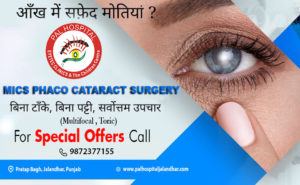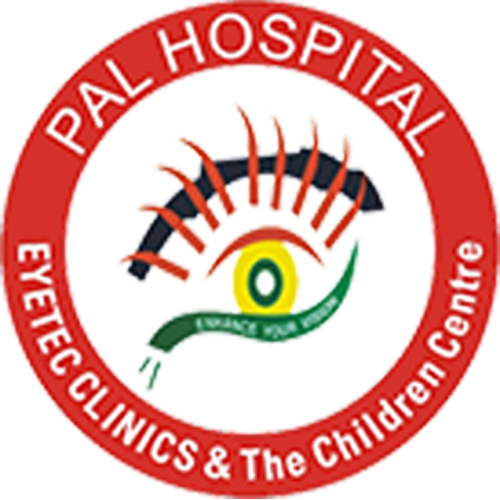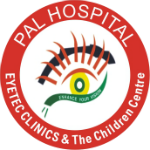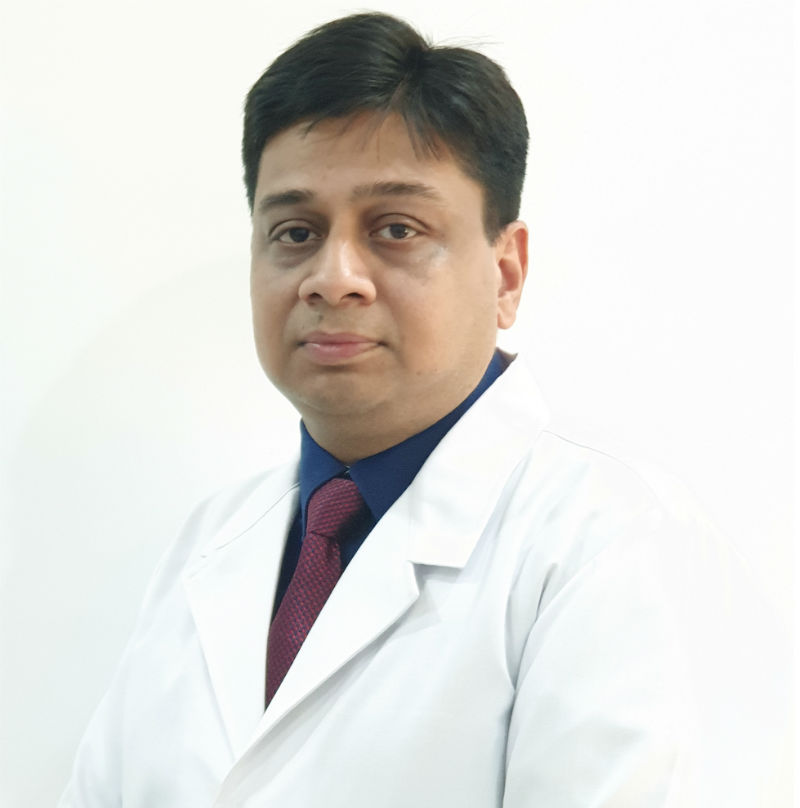

What is Glaucoma? Glaucoma Treatment In Jalandhar
Glaucoma is a complex disease in which damage to the optic nerve leads to progressive, irreversible vision loss. Glaucoma is the second leading cause of blindness. glaucoma does affect peripheral vision, it also affects central vision. Glaucoma patients with moderate or severe disease often describe looking through a fog which extends into their central vision. Because of this fogging, people with glaucoma recognize fewer letters in one glance. They must therefore look at text more times to make their way through a passage. The result is slower reading and particular difficulty with longer words.
At Pal hospital Eyetec Clinics & The Children Centre we have best Glaucoma treatment in Jalandhar. We have ultra-advanced technology. We do offer surgical and medicine solutions to our patients depends on their condition. Pal hospital eyetech clinics & the children centre is the hospital of choice of patients for glaucoma treatment in Jalandhar.

Causes of Glaucoma
With all types of glaucoma, the nerve connecting the eye to the brain is damaged, usually due to high eye pressure.
The most common type of glaucoma (open-angle glaucoma) often has no symptoms other than slow vision loss. Angle-closure glaucoma, although rare, is a medical emergency and its symptoms include eye pain with nausea and sudden visual disturbance.
Treatment includes eye drops, medication and surgery.
Diagnosis / Assesment
- Slit lamp Examination
- GAT
- Gonioscopy
- Fundus Examination
- Perimetry(for diagnosis and to assess progression)
- OCT/retinal nerve fibre head analysis for diagnosis and to assess progression
Treatment Options
-
- Drugs
- Laser
- Surgery

Who is at risk?
- are over age 40
- high Myopia
- have family members with glaucoma
- have high eye pressure
- are farsighted or nearsighted
- have had an eye injury
- use long-term steroid medications
- have corneas that are thin in the center
- have thinning of the optic nerve
- have diabetes, migraines, high blood pressure, poor blood circulation or other health problems affecting the whole body
Glaucoma filtering surgery(Trabeculectomy). Glaucoma Treatment In Jlandhar
The gold standard in treating glaucoma is trabeculectomy in which a small slow and controlled eye fluid ( aqueous) is drained out of the eye into subconjunctival space to keep the eye pressure controlled so that further damage to the optic nerve can be avoided. Can be done as a stand alone procedure or combined with phacoemulsification and cataract removal. Done at the right time gives wonderful results.
If you are frustrated with Glaucoma you are at right place for Glaucoma treatment in Jalandhar.
SLT(Selective Laser Trabeculoplasty). Glaucoma Treatment In Jlandhar
Selective Laser Trabeculoplasty, or SLT, is a form of laser surgery that is used to lower intraocular pressure in glaucoma.
It is used when eye drop medications are not lowering the eye pressure enough or are causing significant side effects. It can also be used as initial treatment in glaucoma. SLT has been in use for more than 25 years around the world.
Are you a glaucoma suspect?
-
- If your disk is suspicious or your disk look like glaucoma patient disk
- If you have normal/high intraocular pressure but you feels and nerve head analysis is normal
When we work
Opening Hours
Dr. Sandeep Pal Bansal
Eye Specialist
14+ Years Experience
[grw place_photo=”https://palhospitaljalandhar.com/wp-content/uploads/2020/02/unnamed.jpg” place_name=”Pal Hospital Eyetec Clinics & The Children Centre – Best Eye Hospital In Jalandhar” place_id=”ChIJx-UAMF1aGjkR6g1A3CMdNCA” pagination=”10″ text_size=”120″ refresh_reviews=true lazy_load_img=true reduce_avatars_size=true open_link=true nofollow_link=true]


Myths About Glaucoma
MYTH : GLAUCOMA CAN HAPPEN ONLY IF THE EYE PRESSURE IS HIGH.
NO, EVEN AT NORMAL PRESSURES PATIENT CAN GET GLAUCOMA AND IT CAN PROGRESS.
MYTH : GLAUCOMA CAN NOT BE TREATED.
NO, IT CAN BE TREATED AND STABLIZED, EITHER WITH DRUGS, LASER, OR SURGERY.
MYTH : ONCE GLAUCOMA SURGERY IS DONE GLAUCOMA VISION WILL NOT DECREASE.
NO, EVEN AFTER BEST OF TREATMENT GLAUCOMA CAN PROGRESS, REGULAR EXAMINATION IS THE ONLY SOLUTION.
MYTH: Glaucoma is inherited, and since no one in my family has glaucoma, I won’t get the disease.
While it is true that certain forms of glaucoma are inherited, and that a family history of glaucoma is a risk factor, there are many glaucoma patients who are the only ones in their families who are diagnosed with this eye disease. It is also possible that there does not appear to be a strong family history because not all family members have been appropriately examined. All patients with glaucoma should share their diagnosis with their family members and ask them to have a dilated eye examination. We recommend that all adults with no signs of eye disease or risk factors have a baseline dilated eye examination at age 40. This is because many early signs of disease and changes in vision can start to occur around this age. And given that glaucoma is symptomless in most cases, it is even more important that family members of patients with glaucoma have their eyes thoroughly examined.
MYTH: There is no reason undergo treatment for glaucoma if there are no symptoms, especially since there is not a cure for the disease.
It is true that most forms of glaucoma don’t produce symptoms, and many of the treatments have some side effects or have an impact on quality of life. While there is currently no cure for glaucoma, there are, however, effective medications, lasers, and surgeries to help slow the disease. The eye doctor’s job is to slow the disease to minimize the chances of developing visual field damage that impacts the ability to function. Certainly, there are side effects of treatments, but you, along with your eye doctor, can work together to find a suitable solution to minimize these unwanted effects. Furthermore, while treatment is not a guarantee that the glaucoma will not worsen (there are situations where the eye pressure is well-controlled, but glaucoma can still progress), it is known that if patients with glaucoma are left untreated, many will proceed to lose vision.
MYTH: Glaucoma only occurs if you have elevated eye pressure.
While it is true that elevated eye pressure is a major risk factor (and can be causative) of glaucoma, some people with elevated eye pressure do not develop this eye disease. It is also possible to have severe glaucoma with so-called “normal” eye pressures. People in the first group have ocular hypertension and people in the latter group have normal-tension glaucoma (NTG).
Ocular hypertension occurs when there are documented high eye pressures but no evidence of optic nerve or field of vision damage. However, depending on risk factors and the specific patient situation, some eye doctors will recommend treating the elevated eye pressures. In fact, in one well-designed randomized controlled trial, called the Ocular Hypertension Treatment Study (OHTS), people with ocular hypertension who were treated with eye pressure lowering medications, reduced their risk of developing glaucoma by more than 50 percent. What is important to note, however, is that a relatively small percentage, about 9.5 percent of untreated patients, developed glaucoma during the 5 years of the study, compared to 4.4 percent of those who were treated.
MYTH: Glaucoma only affects the elderly.
While it is true that the risk of having glaucoma increases as we get older, and that the majority of open-angle glaucoma is age-related, this eye disease can affect people of all ages, even newborns. For example, some babies have congenital glaucoma, while other children have other eye diseases that lead to secondary glaucoma. The same is true for adults—one can have an eye condition, for example uveitis, that results in a secondary glaucoma. There are also other types of glaucoma that often manifest in patients between ages 20 and 50, such as pigmentary glaucoma. However, for the majority of open-angle glaucoma cases in the United States, the prevalence increases in older age groups. Persons ages 70 and older are at 3- to 8-fold greater risk of having primary open-angle glaucoma compared to persons in their 40s.
MYTH: If you have 20/20 vision and no symptoms, you won’t develop glaucoma.
Glaucoma is often called the “silent thief of sight” because people will not notice symptoms until the glaucoma is moderate or advanced. The definition of early glaucoma is based on the fact that you do not even need to have problems with your peripheral (side) vision, but is rather determined by your eye doctor’s observation of the appearance of your optic nerve. Therefore, even though you will not have symptoms in early glaucoma, if untreated, vision will slowly deteriorate. Another reason that patients do not notice changes in their vision, is that one eye can compensate for any defects in the other eye’s peripheral vision. Sadly, it is possible that people can have advanced peripheral vision loss without realizing it. Furthermore, it is known that the later the disease is diagnosed and treated, the worse the long-term outcome. This observation has been borne out in numerous clinical studies and emphasizes the importance of identifying and treating glaucoma early.



